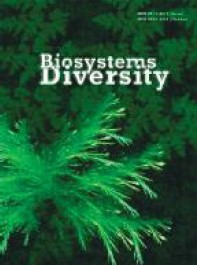Application of remote sensing data for monitoring eutrophication of floodplain water bodies
Application of remote sensing data for monitoring eutrophication of floodplain water bodies
Author(s): E. V. Fedonenko, O. M. Kunakh, Y. A. Chubchenko, O. V. ZhukovSubject(s): Physical Geopgraphy, Environmental Geography
Published by: Дніпропетровський національний університет імені Олеся Гончара
Keywords: GIS-technology; nature conservation; nature reserve; water body connectivity; spatial pattern; spatial ecology;
Summary/Abstract: The aim of this article was to investigate the influence of structural features of the floodplain water network on the spatial and temporal dynamics of chlorophyll-a concentration as an indicator of eutrophication. The research was conducted in the waters of the “Dnipro-Orilskiy” Nature Reserve. The geographic information base with polygonal objects which represented water bodies of the reserve was created on the basis of detailed geographical maps and the high resolution space images. The water bodies were characterized using such parameters as the distance of the water body centroid from the nearest shore of the Dnipro River, the area of the water body, the order of the water body and the connectivity of the water body. Chlorophyll-а concentration was estimated based on the surface algal bloom index. The information was obtained about 148 water bodies, 141 of which are water bodies in the floodplain of the Dnipro River. The area of floodplain water bodies within the reserve was 3.28 million m2. The area of floodplain water bodies ranged from 300–232,500 m2. Trophic State Index allows us to estimate the trophic level of Dnipro River waters as mesotrophic, water bodies of first and second order as eutrophic, and water bodies of third and fourth order as hypereutrophic. The dynamics of chlorophyll-a content in water followed the seasonal course of temperatures. The concentration was lowest in the cold period of the year and reached its maximum in the second half of summer. The autumn decrease occurred at the end of September. The seasonal course of air temperature was superimposed on the peculiarities of the temperature regime of a particular water body, which depended on its depth and flow rate. The time, water body area, distance from the Dnipro River channel, connectivity and order of water bodies were the statistically significant predictors of chlorophyll concentration in water and were able to explain 85% of the variation of this indicator. The increase in chlorophyll-a concentration with increasing order of a water body is due to a decrease in the intensity of water exchange and a decrease in the depth of water bodies of higher order. An increase in the order of a water body is accompanied by a branching network of water bodies, the ability of water bodies to clear sediments decreases. Sediment accumulation leads to a decrease in their depth. Warming of shallow ponds and accumulation of organic matter in them are factors of intensive growth of blue-green algae. The evacuation of surplus organic matter, which results from mass vegetation development with excessive nutrient inputs, is a key driver of the eutrophic regime of water bodies. The increasing importance of regulatory processes develops in agreement with an increase in chlorophyll-a concentration in a water body. The importance of the considered factors reaches the highest level in summer time, when simultaneous maximum warming of water bodies and minimum water level in them take place. Accordingly, the differences between deep and relatively cool water bodies and shallow water bodies that warm up quickly, which significantly stimulates the growth of organic mass, reach the greatest contrast. The spatial patterns of variation in chlorophylla concentration have a complex multiscale structure, indicating the multiple nature of the acting factors. The spatial variability was represented as a composition of broad-scale and medium-scale spatial processes. The broad-scale process is most dependent on connectivity, whereas for the medium-scale process the leading one is the effect of water body order.
Journal: Biosystems Diversity
- Issue Year: 30/2022
- Issue No: 2
- Page Range: 179-190
- Page Count: 12
- Language: English

